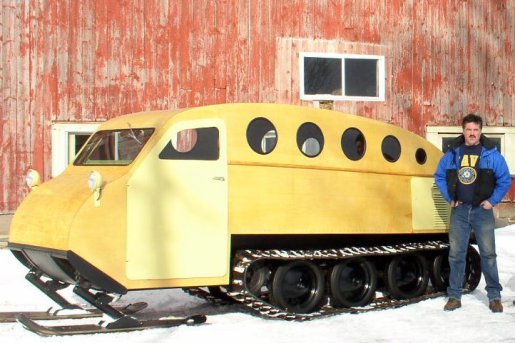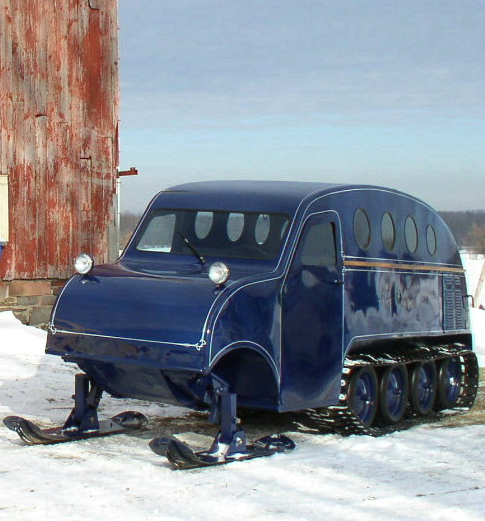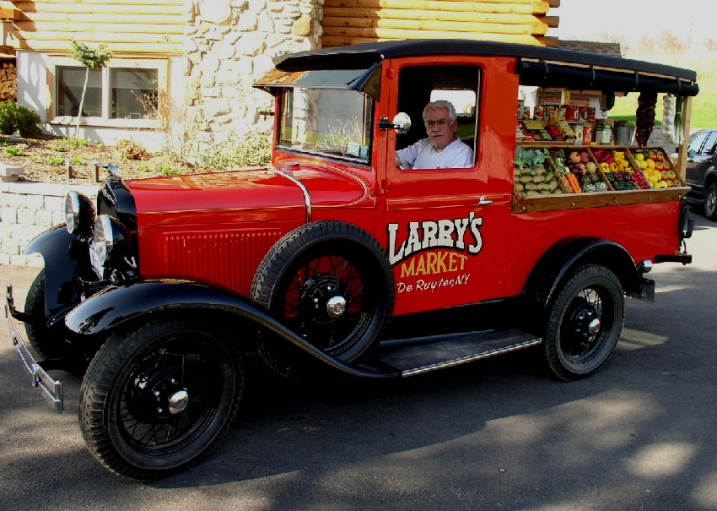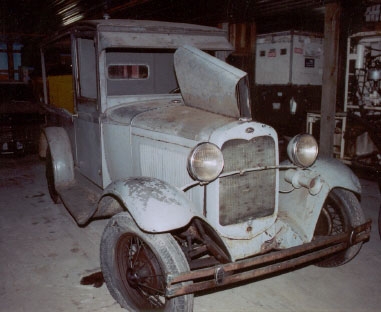This truck has been restored to as
close to original specifications as possible.
by Gary Wilkinson

1931 Ford Peddler’s Wagon restored by Larry Loffredo
It was the end of April this year when I snapped the picture of Larry Loffredo behind the wheel of his then recently restored 1931 Ford Model A Peddler’s Wagon in DeRuyter, NY. It was just six months prior to this when I met with him as he was about to begin the complete frame-off restoration of this very unique truck. What started out as a ‘barn-fresh’ truck that had been stored in a Westchester County, NY barn, for thirty years is now out-and-about and grabbing a lot of attention at local and national car shows.
These Peddler’s Wagons were ubiquitous in neighborhoods across the country when they were new. They are a very faint memory for the few that may remember when the ‘Produce Man’ made his rounds.

1931 Ford Peddler’s Wagon prior to the start of its restoration
It is difficult to find one of these unique trucks today, anywhere. If you are lucky enough to see one, it is safe to say it would never measure up to the quality and the workmanship that has gone into Larry’s truck. He said, “The guys (Artie and Mike) that work exclusively on the George Staley car collection) did an outstanding job on this truck and in a relatively short period of time – almost six months to the day from start to finish.” (George Staley owns over 130 classic cars, some are one of a kind. He has donated approximately 80 cars from his collection to the North East Classic Car Museum in Norwich, NY where they can be enjoyed by the public. Larry is George’s son-in-law.)
While Artie (mechanical) and Mike (body-work) did their respective things, Larry was busy building the wood structure that makes up the trucks bed and produce display racks. This triple team restoration approach really paid off in getting the project completed in ‘record time.’
Officially the truck is called a Canopy Top Express Delivery Wagon. Back in 1931, Ford manufactured the chassis, motor and basically everything from the cab forward. The rear portions of these trucks were constructed by independent body builders. Back then companies such as Stoughton Co. in Wisconsin did this type of work. For this truck, Larry became the custom body shop. Pictures from calendars and other documents became his blue prints. Larry has worked with wood professionally and as a hobby for most of his life. The finished product reflects his skill and knowledge of his craft.
When the truck was completed this spring, it was time for its initial shake-down run. Larry said, “I ran into the normal stuff that you would expect after a project like this (rattles, lights not working, etc.). What I did not expect was hitting the brakes and having my foot go right to the floor.” He was able to stop the truck without incident. The brakes were fixed along with a minor gasoline leak. Since that first drive, there have been few problems.
This truck is a driver. If it gets dirty, Larry cleans and details it. If his destination is greater than an hours drive from his home, he will trailer it. However, the truck is just a few inches too tall to fit into an enclosed carrier, so it has to be trailered in the open.
One thing most restorers do not have to deal with is stocking their vehicles with fruits, vegetables and other items that would have been carried in these trucks. Larry has found an assortment of authentic looking plastic substitutes to fill the custom oak racks. Larry said, “I found most of this stuff at local hobby shops and at JoAnn Fabrics. I continue to look for vintage Coke bottles, soda, cases, boxes and cans at local antique shops. He is fortunate to live in the heart of one of the largest antique mecca’s in New York State – the Madison/Bouckville area. This has got to make the search for these items a little easier.
Larry has restored his truck to as close to original specifications as possible. The engine and the frame serial numbers even match. He has made a couple of improvements. He added a battery cut-off switch on the dash and a fuel cut-off under the hood.
The collector/antique car hobby is an important part of Larry’s life, even more now that he has retired from his construction business. His fleet of cars continues to grow. In part, he owns an award winning red 1959 Ford Retractable (hard top convertible) and a recent purchase, needing only some cosmetics, is a 1957 Lincoln Premier convertible. He belongs to several different car clubs and association, as well as being a member of the car museum in Norwich.
Future projects are still up in the air. He is thinking about another, as he said “odd ball truck”, a 1958-1960 Oldsmobile, Pontiac or Mercury convertible or something else that might catch his interest. Whatever it is, you can expect that it will be completed to the same standard he has followed with his Peddler’s Wagon – flawlessly.






Recent Comments